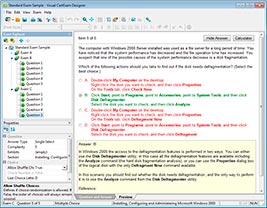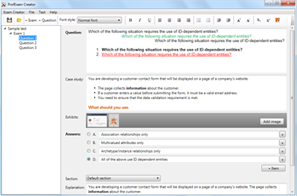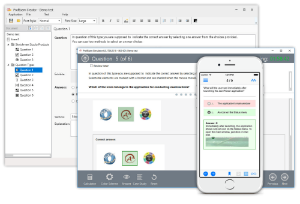Download AWS Certified Data Analytics - Specialty.DAS-C01.Dump4Pass.2025-06-08.109q.vcex
| Vendor: | Amazon |
| Exam Code: | DAS-C01 |
| Exam Name: | AWS Certified Data Analytics - Specialty |
| Date: | Jun 08, 2025 |
| File Size: | 113 KB |
How to open VCEX files?
Files with VCEX extension can be opened by ProfExam Simulator.
Discount: 20%
Demo Questions
Question 1
A company uses Amazon Elasticsearch Service (Amazon ES) to store and analyze its website clickstream data.
The company ingests 1 TB of data daily using Amazon Kinesis Data Firehose and stores one day’s worth of data in an Amazon ES cluster.
The company has very slow query performance on the Amazon ES index and occasionally sees errors from Kinesis Data Firehose when attempting to write to the index. The Amazon ES cluster has 10 nodes running a single index and 3 dedicated master nodes. Each data node has 1.5 TB of Amazon EBS storage attached and the cluster is configured with 1,000 shards. Occasionally, JVMMemoryPressure errors are found in the cluster logs.
Which solution will improve the performance of Amazon ES?
- Increase the memory of the Amazon ES master nodes.
- Decrease the number of Amazon ES data nodes.
- Decrease the number of Amazon ES shards for the index.
- Increase the number of Amazon ES shards for the index.
Correct answer: C
Question 2
A company is planning to do a proof of concept for a machine learning (ML) project using Amazon SageMaker with a subset of existing on-premises data hosted in the company’s 3 TB data warehouse. For part of the project, AWS Direct Connect is established and tested. To prepare the data for ML, data analysts are performing data curation. The data analysts want to perform multiple step, including mapping, dropping null fields, resolving choice, and splitting fields. The company needs the fastest solution to curate the data for this project.
Which solution meets these requirements?
- Ingest data into Amazon S3 using AWS DataSync and use Apache Spark scrips to curate the data in an Amazon EMR cluster. Store the curated data in Amazon S3 for ML processing.
- Create custom ETL jobs on-premises to curate the data. Use AWS DMS to ingest data into Amazon S3 for ML processing.
- Ingest data into Amazon S3 using AWS DMS. Use AWS Glue to perform data curation and store the data in Amazon S3 for ML processing.
- Take a full backup of the data store and ship the backup files using AWS Snowball. Upload Snowball data into Amazon S3 and schedule data curation jobs using AWS Batch to prepare the data for ML.
Correct answer: C
Question 3
A company currently uses Amazon Athena to query its global datasets. The regional data is stored in Amazon S3 in the us-east-1 and us-west-2 Regions. The data is not encrypted. To simplify the query process and manage it centrally, the company wants to use Athena in us-west-2 to query data from Amazon S3 in both Regions. The solution should be as low-cost as possible.
What should the company do to achieve this goal?
- Use AWS DMS to migrate the AWS Glue Data Catalog from us-east-1 to us-west-2. Run Athena queries in us-west-2.
- Run the AWS Glue crawler in us-west-2 to catalog datasets in all Regions. Once the data is crawled, run Athena queries in us-west-2.
- Enable cross-Region replication for the S3 buckets in us-east-1 to replicate data in us-west-2. Once the data is replicated in us-west-2, run the AWS Glue crawler there to update the AWS Glue Data Catalog in us-west-2 and run Athena queries.
- Update AWS Glue resource policies to provide us-east-1 AWS Glue Data Catalog access to us-west-2. Once the catalog in us-west-2 has access to the catalog in us-east-1, run Athena queries in us-west-2.
Correct answer: B
Question 4
A large ride-sharing company has thousands of drivers globally serving millions of unique customers every day.
The company has decided to migrate an existing data mart to Amazon Redshift. The existing schema includes the following tables.
- A trips fact table for information on completed rides. A drivers dimension table for driver profiles.
- A customers fact table holding customer profile information.
- The company analyzes trip details by date and destination to examine profitability by region.
- The driver’s data rarely changes. The customers data frequently changes.
What table design provides optimal query performance?
- Use DISTSTYLE KEY (destination) for the trips table and sort by date. Use DISTSTYLE ALL for the drivers and customers tables.
- Use DISTSTYLE EVEN for the trips table and sort by date. Use DISTSTYLE ALL for the driver’s table. Use DISTSTYLE EVEN for the customer’s table.
- Use DISTSTYLE KEY (destination) for the trips table and sort by date. Use DISTSTYLE ALL for the driver’s table. Use DISTSTYLE EVEN for the customer’s table.
- Use DISTSTYLE EVEN for the drivers table and sort by date. Use DISTSTYLE ALL for both fact tables.
Correct answer: C
Question 5
A company wants to optimize the cost of its data and analytics platform. The company is ingesting a number of .csv and JSON files in Amazon S3 from various data sources. Incoming data is expected to be 50 GB each day. The company is using Amazon Athena to query the raw data in Amazon S3 directly. Most queries aggregate data from the past 12 months, and data that is older than 5 years is infrequently queried. The typical query scans about 500 MB of data and is expected to return results in less than 1 minute. The raw data must be retained indefinitely for compliance requirements.
Which solution meets the company’s requirements?
- Use an AWS Glue ETL job to compress, partition, and convert the data into a columnar data format. Use Athena to query the processed dataset. Configure a lifecycle policy to move the processed data into the Amazon S3 Standard-Infrequent Access (S3 Standard-IA) storage class 5 years after object creation. Configure a second lifecycle policy to move the raw data into Amazon S3 Glacier for long-term archival 7 days after object creation.
- Use an AWS Glue ETL job to partition and convert the data into a row-based data format. Use Athena to query the processed dataset. Configure a lifecycle policy to move the data into the Amazon S3 Standard- Infrequent Access (S3 Standard-IA) storage class 5 years after object creation. Configure a second lifecycle policy to move the raw data into Amazon S3 Glacier for long-term archival 7 days after object creation.
- Use an AWS Glue ETL job to compress, partition, and convert the data into a columnar data format. Use Athena to query the processed dataset. Configure a lifecycle policy to move the processed data into the Amazon S3 Standard-Infrequent Access (S3 Standard-IA) storage class 5 years after the object was last accessed. Configure a second lifecycle policy to move the raw data into Amazon S3 Glacier for long-term archival 7 days after the last date the object was accessed.
- Use an AWS Glue ETL job to partition and convert the data into a row-based data format. Use Athena to query the processed dataset. Configure a lifecycle policy to move the data into the Amazon S3 Standard- Infrequent Access (S3 Standard-IA) storage class 5 years after the object was last accessed. Configure a second lifecycle policy to move the raw data into Amazon S3 Glacier for long-term archival 7 days after the last date the object was accessed.
Correct answer: A
Question 6
A regional energy company collects voltage data from sensors attached to buildings. To address any known dangerous conditions, the company wants to be alerted when a sequence of two voltage drops is detected within 10 minutes of a voltage spike at the same building. It is important to ensure that all messages are delivered as quickly as possible. The system must be fully managed and highly available. The company also needs a solution that will automatically scale up as it covers additional cites with this monitoring feature. The alerting system is subscribed to an Amazon SNS topic for remediation.
Which solution meets these requirements?
- Create an Amazon Managed Streaming for Kafka cluster to ingest the data, and use an Apache Spark Streaming with Apache Kafka consumer API in an automatically scaled Amazon EMR cluster to process the incoming data. Use the Spark Streaming application to detect the known event sequence and send the SNS message.
- Create a REST-based web service using Amazon API Gateway in front of an AWS Lambda function. Create an Amazon RDS for PostgreSQL database with sufficient Provisioned IOPS (PIOPS). In the Lambda function, store incoming events in the RDS database and query the latest data to detect the known event sequence and send the SNS message.
- Create an Amazon Kinesis Data Firehose delivery stream to capture the incoming sensor data. Use an AWSLambda transformation function to detect the known event sequence and send the SNS message.
- Create an Amazon Kinesis data stream to capture the incoming sensor data and create another stream for alert messages. Set up AWS Application Auto Scaling on both. Create a Kinesis Data Analytics for Java application to detect the known event sequence, and add a message to the message stream. Configure an AWS Lambda function to poll the message stream and publish to the SNS topic.
Correct answer: D
Explanation:
Reference: https://aws.amazon.com/kinesis/data-streams/faqs/ Reference: https://aws.amazon.com/kinesis/data-streams/faqs/
Question 7
A company leverages Amazon Athena for ad-hoc queries against data stored in Amazon S3. The company wants to implement additional controls to separate query execution and query history among users, teams, or applications running in the same AWS account to comply with internal security policies.
Which solution meets these requirements?
- Create an S3 bucket for each given use case, create an S3 bucket policy that grants permissions to appropriate individual IAM users. and apply the S3 bucket policy to the S3 bucket.
- Create an Athena workgroup for each given use case, apply tags to the workgroup, and create an IAM policy using the tags to apply appropriate permissions to the workgroup.
- Create an IAM role for each given use case, assign appropriate permissions to the role for the given use case, and add the role to associate the role with Athena.
- Create an AWS Glue Data Catalog resource policy for each given use case that grants permissions to appropriate individual IAM users, and apply the resource policy to the specific tables used by Athena.
Correct answer: B
Explanation:
Reference: https://aws.amazon.com/athena/faqs/ Reference: https://aws.amazon.com/athena/faqs/
Question 8
A company wants to use an automatic machine learning (ML) Random Cut Forest (RCF) algorithm to visualize complex real-world scenarios, such as detecting seasonality and trends, excluding outers, and imputing missing values.
The team working on this project is non-technical and is looking for an out-of-the-box solution that will require the LEAST amount of management overhead.
Which solution will meet these requirements?
- Use an AWS Glue ML transform to create a forecast and then use Amazon QuickSight to visualize the data.
- Use Amazon QuickSight to visualize the data and then use ML-powered forecasting to forecast the key business metrics.
- Use a pre-build ML AMI from the AWS Marketplace to create forecasts and then use Amazon QuickSight to visualize the data.
- Use calculated fields to create a new forecast and then use Amazon QuickSight to visualize the data.
Correct answer: B
Explanation:
Reference: https://aws.amazon.com/blogs/big-data/query-visualize-and-forecast-trufactor-web-session-intelligence-with-aws-data-exchange/ Reference: https://aws.amazon.com/blogs/big-data/query-visualize-and-forecast-trufactor-web-session-intelligence-with-aws-data-exchange/
Question 9
A retail company’s data analytics team recently created multiple product sales analysis dashboards for the average selling price per product using Amazon QuickSight. The dashboards were created from .csv files uploaded to Amazon S3. The team is now planning to share the dashboards with the respective external product owners by creating individual users in Amazon QuickSight. For compliance and governance reasons, restricting access is a key requirement. The product owners should view only their respective product analysis in the dashboard reports.
Which approach should the data analytics team take to allow product owners to view only their products in the dashboard?
- Separate the data by product and use S3 bucket policies for authorization.
- Separate the data by product and use IAM policies for authorization.
- Create a manifest file with row-level security.
- Create dataset rules with row-level security.
Correct answer: D
Question 10
A company wants to improve the data load time of a sales data dashboard. Data has been collected as .csv files and stored within an Amazon S3 bucket that is partitioned by date. The data is then loaded to an Amazon Redshift data warehouse for frequent analysis. The data volume is up to 500 GB per day.
Which solution will improve the data loading performance?
- Compress .csv files and use an INSERT statement to ingest data into Amazon Redshift.
- Split large .csv files, then use a COPY command to load data into Amazon Redshift.
- Use Amazon Kinesis Data Firehose to ingest data into Amazon Redshift.
- Load the .csv files in an unsorted key order and vacuum the table in Amazon Redshift.
Correct answer: B
Explanation:
Reference: https://aws.amazon.com/blogs/big-data/using-amazon-redshift-spectrum-amazon-athena-and- aws-glue-with-node-js-in-production/ Reference: https://aws.amazon.com/blogs/big-data/using-amazon-redshift-spectrum-amazon-athena-and- aws-glue-with-node-js-in-production/
HOW TO OPEN VCE FILES
Use VCE Exam Simulator to open VCE files

HOW TO OPEN VCEX AND EXAM FILES
Use ProfExam Simulator to open VCEX and EXAM files


ProfExam at a 20% markdown
You have the opportunity to purchase ProfExam at a 20% reduced price
Get Now!




